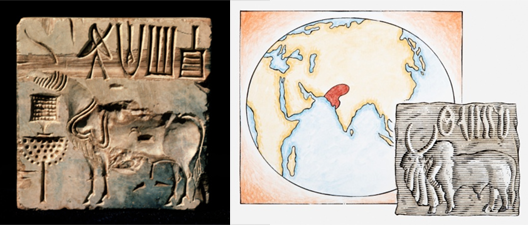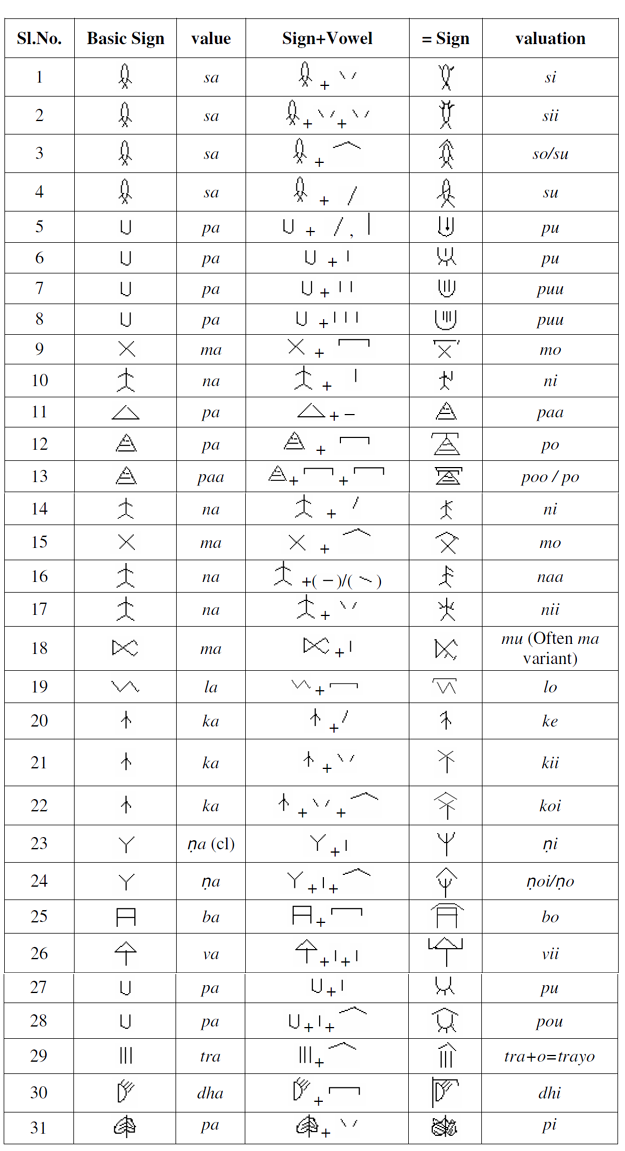Apr 19, 2024
Apr 19, 2024
by Rajat K Pal
Continued from Origin and Etymology of the Valuations of Indus-Saraswati Signs

Consonants with Vowels and Ligatures
One of the main features of the Indo-Aryan language group is the use of sign varieties applying different vowels to consonants. In the European language group vowels are used separately along with consonants. Here addition of vowels changes the consonants sign a bit, but the basic sign can be recognized without much effort. This Indian practice was identified first in Asokan Inscriptions which were inscribed in Brahmi script.
If we take for example the Rock Edict at Girnar, which was deciphered by Alexander Cunningham, we get the following reading
“yam dhammalipi devanam piyen piyadasina”
For the signs of ‘li’ , ‘pi’, ‘vaa’, ‘si’, and ‘naa’ the following changes were made, (Basic consonants and consonants after adding vowels are shown).

Table 6
We can take another example from Sutanuka Inscription, found at the caves in Ramnath Hill near Sirguja where we get the words ‘sutanuka’ & ‘devdasinyi’, from which we can get the following signs.

Table 7
From the Tables 8 & 9 we get the examples of the way the signs were changed when vowels were added to consonants. For overall discussion we take the applications of all vowels in this respect at the following Table 10.

Table 8
Now we shall discuss the changes of Indus signs when vowels were added to consonants in the light of Brahmi applications. We should remember that the time period of Indus-Saraswati Inscriptions was 2000 – 1500 years prior to the Brahmi era. So the uses were in crude form at that time. Through the years those uses took the Brahmi shapes.
Indus Consonants with Vowels

Table 9
Ligature / Compound Letters
I want to give some explanations regarding the use of compound letters in Indus script. Researchers have suggested about the presence of ligatures or small graphic modifications of signs, similar to those used in later Indian scripts (Marshall, 1924; Hunter,1929; Parpola,1969; Mahadevan,1986; Fairservis,1992)
Compound Letters or Consonant Conjuncts
.png)
Table 10
Explanations (Table 11 & 12) :
A. In Brahmi a short vertical line on the upper portion indicates ‘i’ sign and two vertical signs mean ‘ii’. Likewise in Indus Script also we get the same effects. Table 11, Sl. No.1 indicates ‘sii’ and Sl. No.2 of the same table is the graphic variant of the earlier. From Sl. Nos. 10, 14 and 17 (Table 11) we get the examples of ‘ni’ and ‘nii’ (sometimes vertical signs are a bit aligned).
B. In Brahmi a short vertical line below any sign indicates ‘u’,. in Indus also the meaning is ‘u’. In addition to it often the vertical line was used inside a sign. This also had the value of ‘u’. From Table 11 we can take the examples of 4, 5, 6, 7, 8, 27 and 28 (vertical signs often are slight aligned).
C. Two horizontal signs (starting from middle to the opposite ends) above a letter is meant for ‘o’ in Brahmi. In Indus those separate signs are joined. Often we find two joined lines. We can take 9, 12 , 13, etc. as examples (Table 11)
D. One may think about the availability of conjuncts in Brahmi letters. I want to produce one example from Bhaarut Inscription from the book of Heinrich Luders
“Suganam raje …. Silakammamto cha upamno”
A 1 (687) Plate 1 (donation by members of royal family)
Where the compound letters ‘mma’, ‘mto’ & ‘mno’ are found. In Brahmi there are several examples of compound letters.
E. One may raise the question of percentage of the available compound letters. Here I would like to state that Brahmi was written in Prakrit form, which was the literary form of Pali language spoken by common people at that time. Grammarians have accepted that in Brahmi maximum compound letters were simplified. To give some examples I am once again taking examples from the book of H. Luders
Sanskrit Brahmi
i. mriga (deer) miga
ii. srigala (jackal) sigala
iii. sravanaa sona
iv. kousala kosala
v. rishyamriga Isimiga
vi. smasaana susaana
vii. arya aya
viii. kasyapa kasapa
ix. upakraanti ukramti
(exceptionally conjuncts prevail)
x. brahmana bramana
(exceptionally conjuncts prevail)
xi. atmanaa atanaa
xii. sthana tana
xiii. mitra mita
xiv. putra puta etc.
Table 11
Numerical Signs

Table 12
Those are the signs which we get in Indus-Saraswati script. Those are the simple stroke signs. From the number of strokes we can take the values of them. In Brahmi the 1st three numbers are found by one, two and three strokes (3rd century B.C.). In Kharosthi one stroke for the numeric sign 1 is found. Numbers to describe by the number of strokes are common in modern Chinese numerals. In Brahmi from the number four onwards and in Kharosthi from two onwards the use of separate signs was in practice.
Number systems happened to start from Indian civilization, as well as in other civilizations like Egypt etc. The system of India was largely taken by middle-east scholars and from them Europeans accepted the method. Thus came the name Hindu-Arabic numeral system. Later this system was classified in three sub groups i. e. 1) Eastern Arabic Numerals (developed in Iraq), 2) Indian Numeral & 3) Arabic Numeral (developed by Maghreb and Al - Andalus).
In many number signs with past connections (like Roman) we can find that 1, 2, 3 represent simple tally marks. The sign 1 is a single line, 2 is a combination of 2 lines (often connected by a line) and 3 is the combination of three lines (often connected). Generally after number 3, signs become more complex symbols.
We can take the decision that the use of numeric values was started by depicting the exact number of strokes for their valuation. Later with the development of civilization it was observed that use of separate signs for higher numbers was convenient as higher numbers required more space and labour to write. There came the use of cursive signs to describe numbers.
Indus-Saraswati script did not have a sign of zero. It is quite obvious that zero sign was a development of later periods. Even Brahmi did not have that zero sign. But Brahmi had separate numbers for each of tens (10, 20 etc). There were symbols for 100 and 1000 which were often combined in ligatures with the units to signify 200, 300, 2000 etc. But those were later developments. Indus people had no specific sign for numbers. They had just started to express the simple numbers by separate number of strokes for separate numbers. To them ten was the combination of ten strokes. After ten the use of only two numbers are found i.e. 11 & 12. (Strokes for No. 24 were also found. No. 11 was found only on one occasion.)
Signs with Both Numeric and Syllabic Meanings
Use of same signs both for alphabet and numeric values is an old linguistic practice sometimes found in ancient India. It was not a general rule in practice but sometimes somewhere these examples were found. In Brahmi ‘pa’ was used to mention ‘pancha’. As ‘saata (seven)’ became ‘chhata’ then, the alphabet ‘chha’ was used for six (Luders).
In Kharosthi, there were acrophonic examples like the Attic numerals. ‘chatur’ for 4 had a shape very much close to the Kharosthi ‘cha’ sign. Similarly Kharosthi ‘pancha’, ‘satha’ (shashtha), ‘sapta’ and ‘nava’ (5, 6, 7, 9) signs are also close to pa, sha, sa, na signs. Through the method of Acrology those signs evolved and with the progress of time and civilization some modifications were made to distinguish the number signs and alphabet signs.
This practice was not started all of a sudden. In the latter chapters I have mentioned many examples where at least two signs were used for both the purposes. They are (dwa/two & da) and (tra & 3rd). To write ‘putra (son)’ the ‘three’ sign was used as ‘tra’( = putra; reading from right to left).
(The use of sign was first referred to as ‘tra’ by Gadd in 1931. This value was later accepted by Rao.)
Punctuation Marks
The so called ‘punctuation mark’ is properly found in the middle and later stage of Brahmi. Dash and curved horizontal line were used in the first stage. A flower mark to state the conclusion and a circular mark to designate the full stop were started to use.
During early Brahmi period punctuation marks were not very well illustrated. Each letter has been inscribed in an independent manner with some space between words. Distinctive spaces in between the words came along recurrently in the pillar edicts (Asokan), which were not exactly the case in others. The concept of writing each word separately was not utilized always. Punctuation status in Brahmi script can be comprehended like more of an exception.
Indus-Saraswati script being the predecessor of Brahmi did not have use of punctuation marks extensively. We should not forget that Indus inscriptions were not sentences. To separate two words in an inscription dividers like one small or large stroke (or) was used. To mention special mark different determinatives were used. In many occasions no punctuation mark or divider was used.
Previous: Origin and Etymology of the Valuations of Indus-Saraswati Signs
Continued to: Indus-Saraswati Script: Uses of Determinatives and Dictionary Meaning of Single Letters
24-Jan-2012
More by : Rajat K Pal

|
hi JJ, I do not have any comment on that. probably you are right in interpreting the ball signs. rajot |

|
Hi Rajot, What is your interpretation of the three balls with and without the line through? I have found Ashoka coins with this symbol as his royal mudra. It symbolizes two snakes wrapped around a pole as in the universal sign for medicine and the ancient symbol for healing, peace and merchants. Do you have an interpretation for this sign? Sincerely, jj |